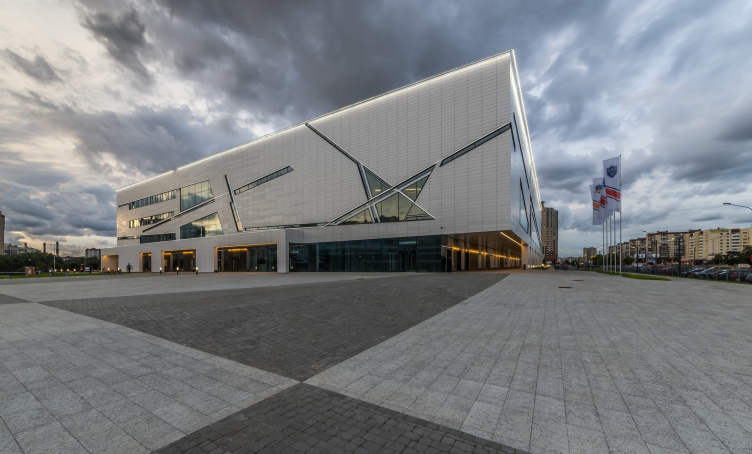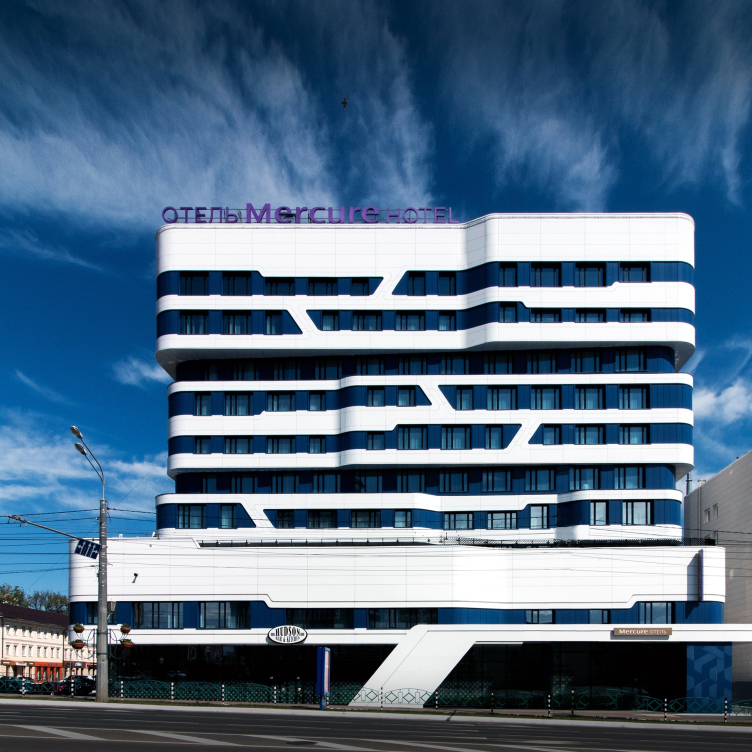In this issue, we are offering you to check out five projects, designed and built by A-Len in different years in different genres and styles.
SKA Home arena. Ice Palace – СКА
Sports complex of SKA hockey club. Implementation, 2016 © A.Len Architectural Bureau
Copyright: © A-Len
| where: | Russia, St. Petersburg | |
| date | 2012 — 2013 / 2013 — 2016 | |
| function: | Sport / Ice Arena | |
| studio: | A-Len http://www.a-len.ru/ | |
| architect: | Sergey Oreshkin |
The video allows you to make sense of the complex logistic connections of the sports complex. Here you can clearly see how the new club building is connected to the Ice Arena by paths leading to the bridge over the Okkervil River; the distribution of traffic and pedestrian flows are also plain to see. It is also easy to assess the scale of the landscaping and open spaces of this “sports town”. In the improvement plan, by the way, the same “skate strokes” are repeated, as on the facades of the complex. With its shapes and natural white clay cladding, it resembles a block of ice that has become the main attraction of this large residential area.
Mercure Hotel
Mercure Hotel. Photograph
Copyright: © Alexander Shemetov
| where: | Russia, Saransk | |
| date | 2014 — 2015 / 2015 — 2018 | |
| function: | Hospitality / Health / Hotel | |
| studio: | A-Len http://www.a-len.ru/ | |
| architect: | Sergey Oreshkin |
The Mercure hotel was built in Saransk for the 2018 FIFA World Cup. Without knowing the city center, one can hardly fully appreciate the task of the architects: the building looks like a feast of colors, shapes, materials – and verticals. In order to fit in with confidence, we decided to use simple volumes and horizontals, and it took a long time to come up with the right colors. Since the context allows a lot here, the company chose one of its favorite areas, using which would have been more problematic in St. Petersburg – bionics. Close-up angles allow you to appreciate the embodiment of curved lines and wavy elements.
Residential building on the Chapaeva Street
| where: | Russia, St. Petersburg | |
| date | 2009 — 2014 / 2014 — 2015 | |
| function: | Residential / Apartment building | |
| studio: | A-Len http://www.a-len.ru/ | |
| architect: | Sergey Oreshkin |
For this house, drone footage is seriously a must: because of the complex site and composition, it will take you a long time to fully appreciate the architectural solution just standing on the street next to it. The camera delicately bypasses the courtyard wing and the blank firewalls of the house, which were designed with a perspective of tearing down the neighboring buildings in mind, and further develop this part of the city. But so far, no new neighbors have appeared. However, the video clearly shows the volumes and rich plastique, inspired by the modernist style of the Petrograd Side – you can look at the openwork lattices and envy for the owners of the terraces, from where the views of historical St. Petersburg spread out.
"I, Romantic" residential complex, Stage 1
| where: | Russia, St. Petersburg | |
| date | 2013 — 2016 / — 2016 | |
| function: | Residential / Residential complex | |
| studio: | A-Len http://www.a-len.ru/ | |
| architect: | Sergey Oreshkin |
One of the first residential complexes on the alluvial land of the Vasilievsky Island, which is well known to everyone who uses the Western High-Speed Diameter due to its spectacular illumination. The drone camera gives a detailed view of the facades, which are quite sophisticated for an economy-class complex: the grid of windows reflects the variety of layouts, the cladding with a considerable number of shades turns the facades into stylized ships with masts, sails and splashing waves. The video does not hide the truth, either: you can plainly see yards flooded with cars and sand-ridden parking lots.
“Light World Inside” health park
Health park “Svetly Mir VNUTRI”
Copyright: © AMM
| where: | Russia, Sestoreck | |
| date | 2015 — / — 2018 | |
| function: | Hospitality / Health / Resort | |
| studio: | A-Len http://www.a-len.ru/AMM | |
| architect: | Sergey OreshkinYuri Mityurev |
This apartment complex in Sestroretsk is inspired by the Karelian nature and the atmosphere of St. Petersburg dachas and resorts. The shape of the buildings resembles the curves of the dunes; the facades are coated with ceramic tiles with a wood-grain effect; the well-thought-out landscaping of the courtyard lures residents out into the street. Even if you cannot see the bay from the window, you can always go out on the operated roof and enjoy the views of the water or the stars.









































































